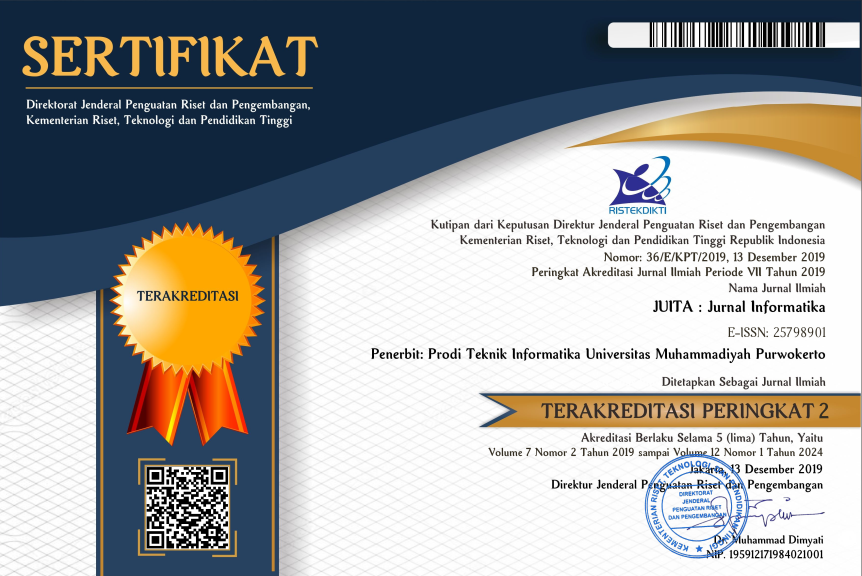Development of Bot for Microservices Server Monitoring Using Life Cycle Approach to Network Design Method
DOI:
https://doi.org/10.30595/juita.v8i2.8422Keywords:
Microservices, Server Monitoring, BotAbstract
This study was conducted on the emergency response system that has been implemented in Demak, Kendal and Batang districts, namely Tanggapin. This system provides services in the form of reporting and actions, as well as information about the health sector, from the availability of hospital rooms to the availability of blood at PMI. Tanggapin uses a mobile-based and web-based platform, where the web is used as a medium for operators to input data and validate incoming reports. Due to complex system services with various supporting features, it requires a microservices architecture to operate independently and in a distributed manner. Because of this dynamic system, realtime monitoring support for server performance is needed via Telegram Bot. The monitoring system was built using the PPDIOO Lifecycle Approach to Network Design and Implementation method because it is reliable and the flow of a process never breaks. The format used to exchange data uses the JSON (Javascript Object Notation) format. This study shows that the monitoring system run well because every test carried out gives the expected results, namely the admin receives a warning message via the Telegram Bot.
References
[1] D. Richter, M. Konrad, K. Utecht, and A. Polze, “Highly-Available Applications on Unreliable Infrastructure: Microservice Architectures in Practice,” in 2017 IEEE International Conference on Software Quality, Reliability and Security Companion (QRS-C), Jul. 2017, pp. 130–137, doi: 10.1109/QRS-C.2017.28.
[2] “Microservices: Flexible Software Architecture [Book].” https://www.oreilly.com/library/view/microservices-flexible-software/9780134650449/ (accessed Aug. 27, 2020).
[3] P. Jamshidi, C. Pahl, N. C. Mendonça, J. Lewis, and S. Tilkov, “Microservices: The Journey So Far and Challenges Ahead,” IEEE Softw., vol. 35, no. 3, pp. 24–35, May 2018, doi: 10.1109/MS.2018.2141039.
[4] B. Mayer and R. Weinreich, “A Dashboard for Microservice Monitoring and Management,” in 2017 IEEE International Conference on Software Architecture Workshops (ICSAW), Apr. 2017, pp. 66–69, doi: 10.1109/ICSAW.2017.44.
[5] M. Cinque, R. Della Corte, and A. Pecchia, “Microservices Monitoring with Event Logs and Black Box Execution Tracing,” IEEE Trans. Serv. Comput., pp. 1–1, 2019, doi: 10.1109/TSC.2019.2940009.
[6] M. A. Rosid, A. Rachmadany, M. T. Multazam, A. B. D. Nandiyanto, A. G. Abdullah, and I. Widiaty, “Integration Telegram Bot on E-Complaint Applications in College,” IOP Conf. Ser. Mater. Sci. Eng., vol. 288, p. 012159, Jan. 2018, doi: 10.1088/1757-899X/288/1/012159.
[7] M. Zennaro, M. Rainone, and E. Pietrosemoli, “Radio Link Planning Made Easy with a Telegram Bot,” in Smart Objects and Technologies for Social Good, Cham, 2017, pp. 295–304, doi: 10.1007/978-3-319-61949-1_31.
[8] H. Setiaji and I. V. Paputungan, “Design of Telegram Bots for Campus Information Sharing,” IOP Conf. Ser. Mater. Sci. Eng., vol. 325, p. 012005, Mar. 2018, doi: 10.1088/1757-899X/325/1/012005.
[9] D. Korotaeva, M. Khlopotov, A. Makarenko, E. Chikshova, N. Startseva, and A. Chemysheva, “Botanicum: a Telegram Bot for Tree Classification,” in 2018 22nd Conference of Open Innovations Association (FRUCT), May 2018, pp. 88–93, doi: 10.23919/FRUCT.2018.8468278.
[10] “PPDIOO Stages > Cisco’s PPDIOO Network Cycle | Cisco Press.” https://www.ciscopress.com/articles/article.asp?p=1697888&seqNum=2 (accessed Aug. 27, 2020).
[11] D. Jaramillo, D. V. Nguyen, and R. Smart, “Leveraging microservices architecture by using Docker technology,” in SoutheastCon 2016, Mar. 2016, pp. 1–5, doi: 10.1109/SECON.2016.7506647.
[12] C. Kaewkasi, Docker for Serverless Applications: Containerize and orchestrate functions using OpenFaas, OpenWhisk, and Fn. Packt Publishing Ltd, 2018.
[13] J. Mohorko, F. Matjaž, and K. Saša, “Advanced Modelling and Simulation Methods for Communication Networks,” p. 6, 2008.
[14] S. Basso, A. Servetti, and J. C. De Martin, “The network neutrality bot architecture: A preliminary approach for self-monitoring of Internet access QoS,” in 2011 IEEE Symposium on Computers and Communications (ISCC), Jun. 2011, pp. 1131–1136, doi: 10.1109/ISCC.2011.5983857.
[15] R. van Tonder and C. Le Goues, “Towards s/engineer/bot: Principles for Program Repair Bots,” in 2019 IEEE/ACM 1st International Workshop on Bots in Software Engineering (BotSE), May 2019, pp. 43–47, doi: 10.1109/BotSE.2019.00019Downloads
Additional Files
Published
How to Cite
Issue
Section
License

JUITA: Jurnal Informatika is licensed under a Creative Commons Attribution 4.0 International License.
















